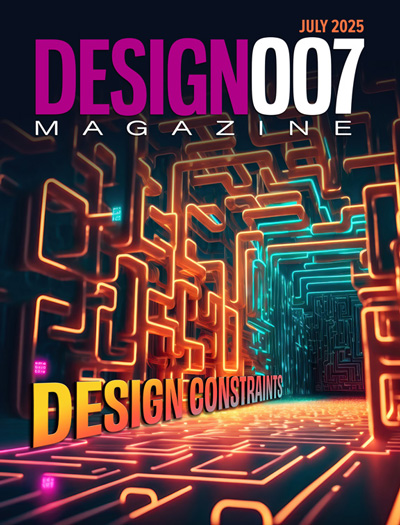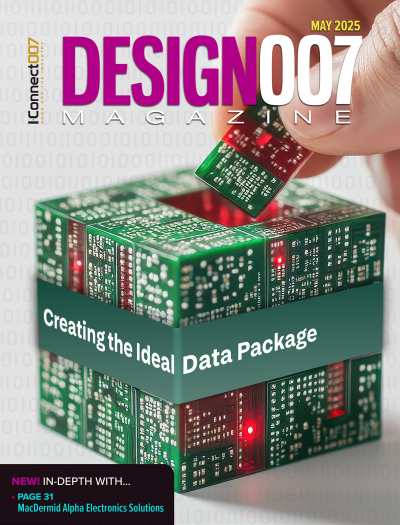-

- News
- Books
Featured Books
- design007 Magazine
Latest Issues
Current Issue
Showing Some Constraint
A strong design constraint strategy carefully balances a wide range of electrical and manufacturing trade-offs. This month, we explore the key requirements, common challenges, and best practices behind building an effective constraint strategy.

All About That Route
Most designers favor manual routing, but today's interactive autorouters may be changing designers' minds by allowing users more direct control. In this issue, our expert contributors discuss a variety of manual and autorouting strategies.

Creating the Ideal Data Package
Why is it so difficult to create the ideal data package? Many of these simple errors can be alleviated by paying attention to detail—and knowing what issues to look out for. So, this month, our experts weigh in on the best practices for creating the ideal design data package for your design.
- Articles
- Columns
- Links
- Media kit
||| MENU - design007 Magazine
Indium Joins Virginia Tech Center for Power Electronics Systems Industry Consortium
June 3, 2025 | Indium CorporationEstimated reading time: Less than a minute
Indium Corporation®, a leading materials refiner, smelter, manufacturer, and supplier to the global electronics, semiconductor, thin-film, and thermal management markets, has joined Virginia Tech’s Center for Power Electronics Systems (CPES), an industry consortium that supports power electronics initiatives to reduce energy use while growing capability.
CPES is dedicated to improving electrical power processing and distribution that impact systems of all sizes, from battery-operated electronics and vehicles to regional and national electrical distribution systems. The organization has a worldwide reputation for its research advances, its work with industry to improve the entire field, and its many talented graduates.
With a specific focus on power device packaging, Indium Corporation continues to advance its portfolio of die-attach, package-attach, and thermal interface materials (TIMs) solutions that are custom-engineered to satisfy the mission profile demands for power electronics applications.
“Advancing materials technology is a key enabler to realize our design goals for power electronics,” said Ryan Mayberry, Senior Application Development Engineer at Indium Corporation. “Through collaboration with CPES, Indium Corporation will leverage innovations in materials science and align research and development initiatives to address future power device requirements.”
Testimonial
"Our marketing partnership with I-Connect007 is already delivering. Just a day after our press release went live, we received a direct inquiry about our updated products!"
Rachael Temple - AlltematedSuggested Items
Siemens, UMC Collaborate to Advance EM/IR Drop Analysis with mPower Technology
07/22/2025 | SiemensSiemens Digital Industries Software announced that it has collaborated with United Microelectronics Corporation (UMC), a leading global semiconductor foundry, to implement Siemens' mPower™ software for electromigration (EM) and IR drop analysis, enabling chip designers to optimize performance and enhance reliability.
Epirus Receives $43.5 Million Contract from U.S. Army for IFPC-HPM Generation II Systems
07/18/2025 | PRNewswireEpirus announced a $43,551,060 contract from the U.S. Army's Rapid Capabilities and Critical Technologies Office (RCCTO).
Eaton Signs Agreement to Acquire Resilient Power Systems
07/16/2025 | BUSINESS WIREIntelligent power management company Eaton announced it has signed an agreement to acquire Resilient Power Systems Inc., a leading North American developer and manufacturer of innovative energy solutions, including solid-state transformer-based technology.
Beyond Design: Refining Design Constraints
07/17/2025 | Barry Olney -- Column: Beyond DesignBefore starting any project, it is crucial to develop a thorough plan that encompasses all essential requirements. This ensures that the final product not only aligns with the design concept but is also manufacturable, reliable, and meets performance expectations. High-speed PCB design requires us to not only push technological boundaries but also consider various factors related to higher frequencies, faster transition times, and increased bandwidths during the design process.
Copper Price Surge Raises Alarms for Electronics
07/15/2025 | Global Electronics Association Advocacy and Government Relations TeamThe copper market is experiencing major turbulence in the wake of U.S. President Donald Trump’s announcement of a 50% tariff on imported copper effective Aug. 1. Recent news reports, including from the New York Times, sent U.S. copper futures soaring to record highs, climbing nearly 13% in a single day as manufacturers braced for supply shocks and surging costs.


